Over the centuries there were numerous inhabitants who emerged in various disciplines and businesses. Some of them are portrayed in the medallions of the council room of Lepri Palace.
Sextus Propertius (Umbria 50 BC – Rome BC)
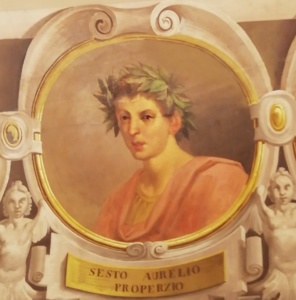
He is from a noble family, whose fall was due to the Perugia’s War of the 41 b.C. between Ottaviano and Antonio. It saw the destruction of Perugia and the succumb to the local aristocracy. Propertius went to Rome very young and immediately entered the literary circles, much appreciated by Mecenate as excellent elegiac poet. The love and passion for the noblewoman Cynthia is the great theme of the first two books of elegies, while the second two also deal with ‘political’ topics and are inspired by the ethical restoration of Ottaviano Augusto. Sextus Propertius is one of the great poets of Latin literature. Many cities in Umbria, including Bevagna (the Roman Mevania he mentioned) were nominated as his place of birth, hence the so-called “Propertius issue” is still unresolved.
Blessed Giacomo Bianconi (Bevagna 1220 – 1301)
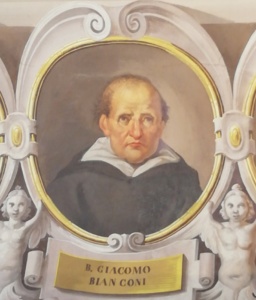
Religious man. He came from a noble family: his mother Vanna was from Giorgi Alberti family. He entered the Order of the Dominicans or Preachers at a very young age and he founded a convent in his city, today next to the church named after him overlooking Piazza Filippo Silvestri. Strict defender of the faith, he strived by preaching against the heresies that meandered in Umbria, especially that Nicolaita, which among other contests denied the divinity of Jesus and opposed ecclesiastical celibacy. Another theological battle was against the sect of the ‘Holy Spirit’ which in Bevagna had established itself with a certain virulence. His cult, confirmed in 1672 by Pope Clement X, is kept alive by the Bevagna inhabitants and celebrated on 23rd August. His life, made up of prayer and penance (he practiced the fasting and suffering of cilice), did not prevent him from returning from Pisa, where he was Prior of the Dominicans, to Bevagna burnt by Frederick II. He helped and rebuilt the ruins. He wrote two treatises Speculum humanitatis Salvatoris Iesu Christi and De ultimo Iudicio Universali Sive Speculum Peccatorum. His mummified body, revered relic, lies in a crystal urn that is unveiled in August during his celebration days.
Alfonso Ceccarelli (1532 – 1583).
Polygraph, forger. He was son of the notary Claudio di Nicola and of Tarpea, from Spetia family. He graduated in medicine, married the noble Imperia Ciccoli, with whom he had nine children and began to practice the profession in the cities of Umbria, Marche and Lazio. His real passion was history, the origins of the family groups, the genealogies, the local chronicles, going through archives and manuscripts in a sort of frenetic obsessive invention, like Borges, of an amazing universal Bibliotheca Mundi. He began to write about everything, about prophecies and spells, geography and botany, fluvial waters (De tuberibus, about truffle and De Clitumno, about the famous river that ends in Bevagna) and, when sources were scarce, he invented phantoms historians of which he commented non-existent works. The historiographical eversion never stopped, it didn’t find obstacles, so much that it used over thirty phantom authors and as many titles. But the vortex that overwhelmed him was when he faced hereditary and testamentary questions of important families linked to the Church. On complaint, he was arrested and imprisoned in Tor di Nona on 15th February 1583, and perhaps tortured. He recognized numerous fakes and drew up a defensive memory where he claimed good faith and material errors. Tried and sentenced to capital punishment (Pope Gregory XIII refused the pardon) at the dawn of June 1st, 1583, he was put to death. He calmly faced it and, being noble, he was executed not by hanging but by cutting decapitation. It is not certain if he also suffered the severing of his right hand, which he had written so many fake news.
A genius forger
Alfonso Ceccarelli (Bevagna 1532 – Rome 1583), doctor and scholar, was the brilliant author of popular texts on various subjects, but also the “most inventive counterfeiter of the Renaissance” (P. Toubert), capitalizing on the notary professionalism of his grandfather and father. His history is well renown: many high-ranking families with important (even papal) relatives asked for his services as a forger of pseudo-ancient documents to credit the dubious ownership of titles, land and buildings. But, once his tricks were discovered, he was touched by a dramatic fate. On 9th July 1583 Ceccarelli was put to death by the pontifical justice in front of Castel Sant’Angelo. Yet his literary production is certainly interesting. Among the works in which he is inspired by Umbria and his beloved Bevagna “About Truffles. Opusculum de tuberibus” is worth mentioning, in the edition by Arnaldo Picuti and Antonio Carlo Ponti, with translation by Daniele Di Lorenzi, foreword by Erminia Irace, contributions by Rita Boini and Alessandro Menghini (Perugia, EFFE, Fabrizio Fabbri Editore, 1999) and De Clitumno , flumine celeberrimo Opusculum, in the edition by Lucia Bertoglio, translation by Claudio Stella, foreword by Elena Laureti (Foligno, Federico Frezzi Research Center, 2012).
In the text About Truffles on the name, shape, species, places, temperature, properties of the valuable tubers, he inserts a passage in which he captures his preference for his native land. In fact, he writes that people how appreciated round, medium-sized, not lumpy, black on and off, heavy, fragrant, aromatic, sweet, pleasant to take born in Umbria and, to be precise, in Spoleto county-side truffles instead of white truffles. Black truffles, moreover, must be harvested at the end of autumn and throughout the winter.
In “De Clitumno”, Ceccarelli returns to promote the city of origin, linking the virtue of its waters to that of the white herds. In fact, he remembers that “Silio Italico, describing the Clitunno flowing through the plain of Bevagna, from which white bulls are generated to be sacrificed to Jupiter Capitoline, he says the following words: “Bevagna sits grazing the great bull / gift to Jupiter”. (A.C. Ponti and R. Segatori in the Great Dictionary of Bevagna, 8 and 10).
Ascensidonio Spacca named Il Fantino (Bevagna 1557 – 1646).
Painter and probably a master of Andrea Camassei, Il Fantino was a local painter – he never left Valle Umbra – but left excellent paintings and pictorial cycles in his city and neighboring towns. In Spello he realized the beautiful frescoes Visitation and Birth of the Virgin in the church of Santa Maria di Vallegloria annexed to the monastery of the Clarisse; in Bevagna he frescoed The Pietà in the church of San Francesco; in the church of San Domenico he left the beautiful Madonna del Rosario and in Castelbuono he realized a Madonna and Child in the church of Santa Maria Assunta, in the Sanctuary of the Madonna delle Grazie he frescoed the Madonna Costantinopoli. Among his most expressive works, the following cities are only a small list where his paintings are kept: Montefalco, Gualdo Cattaneo, Trevi , Bettona, Foligno and even Spoleto, Terni and Papigno. The Bevagna Museum hosts many other sacral works of Il Fantino.
Andrea Camassei (Bevagna 1602 – Rome 1649)
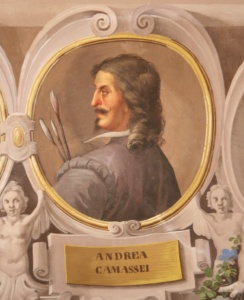
Painter. Perhaps a pupil of Il Fantino, many documents handed down that he was one of Domenichino’s pupils in Rome, where he settled in 1625. In 1628 he works with Andrea Sacchi, under the guidance of Pietro da Cortona at Castel Fusano and entered the circle of the artists who work for Pope Urban VIII (Maffei Barberini). He conquers a prominent place, working for the noble families of the Roman aristocracy, such as the Barberini Altieri and Caracciolo families. Many of his frescoed works have been lost, a large group of paintings remain in museums, including The Massacre of the Niobids, 1638-1639, The Hunt of Diana, The Assumption of the Virgin, The Nativity, Cain and Abel (Fondazione Cassa Risparmio) Perugia), Combat of Gladiators (Museo del Prado). He is a great designer and engraver and his tables are scattered in public and private collections in Europe, including the Royal Collection of Queen Elizabeth II Windsor. In Bevagna his works are in the Museum of Palazzo Lepri and in the churches of Santa Margherita and San Michele Arcangelo (Cappella Spetia).
Fabio Alberti (Bevagna 1719 – 1803)
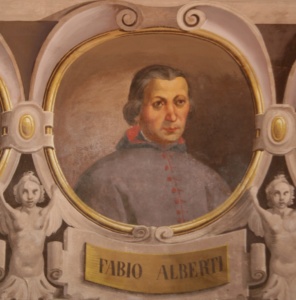
Historian. Abbot and General Vicar in various cities of the Papal States in Central Italy, in 1753 he began to draft the Rerum Mevaniensium […] tabulae chronologicae, whose still-unpublished manuscript is preserved in the municipal Archive of Bevagna. Passionate guardian of the history of Mevania and Bevagna, he was also a tireless collector of archaeological finds he donated to the Municipality. In 1783 he published in Foligno: Old and modern news concerning Bevagna (reprinted in Venice in 1785), the word Bevagna for the famous geographic encyclopedic repertoire of Anton Friedrich Büsching: Erdbechreibung, 1787, besides Sulla Patria of Sesto Aurelio Properzio, 1781 and in 1783, printed in Rome, the De sacris utensilibus tractatus. Alberti was also an expert on herbal medicine. His country house in the hills, in the Arquata locality, is now home of the Adanti Winery.
Alessandro Aleandri (Bevagna 1762 – 1838)
Agronomist, politician. A lawyer of enlightened culture, a versatile and profound writer, Aleandri strongly denounced in his books and not only the intolerable living conditions of the peasants at the time of Pius VI. Governor of various cities of the Papal States, he proposes radical improvements both in techniques and in land administration. As a good Enlightenment man, he was also a poet and lover of chemistry and physics. Fascinated by republican ideas, he was elected first senator of the Roman Republic from 1798 to 1799, then President of the Senate and then President of the Consulate. During the Napoleonic era it was held apart in its Bevagna to cultivate studies and its estates. After the Restoration he returned to hold papal administrative offices. His main work is The Enlargement of Agriculture and the Arts in the Papal States, 1789. Also, worth mentioning The Georgian Essay on the properties of the waters of Lattone stream and the trading of Bevagna’s canvases, 1785; Research on aerostatic art, 1787; Dell ‘Annona, 1794.
Francesco Torti (Bevagna 1763 – 1842)
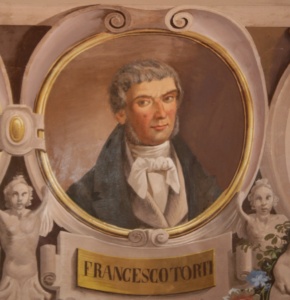
Literary critic and narrator. His father was a jurisconsult. He went to Rome to complete his juridical studies, without ever practicing law. He devoted himself to the study of Italian literature and other European literature, becoming an acute and progressive scholar. Since the Roman times, he was a friend of the authoritative Vincenzo Monti, the famous translator of the Iliad. He professes modern linguistic and antipurist ideals, and fights for a living and spoken language, close to the people. He writes an epigram on the death of Monti’s son-in-law, Count Giulio Perticari, from whom derives his hate. A Catholic, but not entirely under the control the Church operating in Umbria as a Papal State, Torti writes the epistolary novel Correspondence of Monteverde or Moral Letters About Happiness, in which he claims concrete action to alleviate the conditions of ignorance and poverty of the population, especially towards the feminine condition, also through the active work of priests in step with the times, open to novelties, not only pastors in the spiritual and cult sphere.
Ciro Trabalza (Bevagna 1871 – Rome 1936)
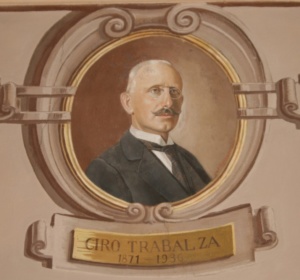
Grammar and literary critic. From a small-bourgeois family, he studied with scholarships in the authoritative Collegio Cicognini of Prato, where he also studied Gabriele D’Annunzio, as it is reported in his beautiful autobiography, posthumously published by his niece Maria Raffaella, entitled The poplar of S. Filippo, Foligno, Edizioni dell’Arquata, 2009. She also followed a study on “Augusta Perugia”, the magazine he founded and directed in Perugia between 1904 and 1909. Director between 1921 and 1928 of various cultural institutes abroad, he devoted himself to philological studies, publishing in 1908 the fundamental History of Italian grammar, which is still unreachable. He wrote a lot on literature and philosophy for newspapers and magazines. In 1896 the Publishers Crescimbeni and Granieri printed his thesis on the life and works of Francesco Torti from Bevagna (with a letter from Luigi Morandi, first scholar of Giuseppe Gioacchino Belli) and Essay on Umbrian-Italian vocabulary, 1905, first in Umbria.
Filippo Silvestri (Bevagna 1873 – 1949)
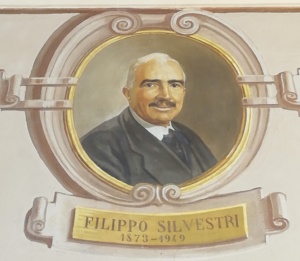
Scientist. He is well renowned amongst Bevagna inhabitants as the “world famous entomologist”, as it is engraved on the plinth that supports his bust in the gardens of Piazza Gramsci. He had a true Umbrian glory and as a student he published a study of botany, entitled Contribution to Mevania’s Vegetation, Perugia, 1892. He also dedicated himself to ornithology with Contribution to the study of Umbrian birdlife, Perugia. As pupil of Giovan Battista Grassi, the greatest Italian zoologist, he began studying entomology, the fascinating world of insects, which took him to the professorship at the Agricultural Institute of Portici, where he taught until 1948, year of his retirement. He went for the first time to Stockholm at the International Congress of Entomology. Silvestri, followed by his fellow countryman Giuseppe Rossetti, began his scientific wanderings around the world with Patagonia, so much that one could say that there really was no country where he did not go, as a pioneer, often on foot, as it happened in the Andes. World-wide renowned among the founders of agrarian entomology, Silvestri theorized the biological fight against harmful insects through other insects. His Memories and scientific itineraries, Naples 1959, is composed by 789 pages of very pleasant reading on dozens and dozens of exotic and non-exotic places of the earth.
Mario Mattòli (Tolentino 1898 – Roma 1980)
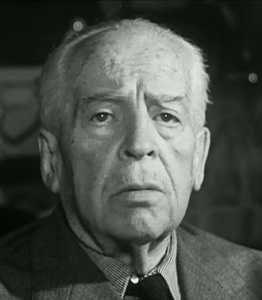
Film director. He was born in Tolentino where his father Aristide was a doctor, a descendant of an ancient glorious family of Bevagna. Assault infantryman during the Great War, he delighted in painting. Author from 1934 to 1966 of 84 films (of which 16 with Totò), in 1936 Mattòli shot in Bevagna, with professional actors and people of the country – anticipating the actors taken from the path of neorealist cinema – the playful and poetic “Music in the Square”. He was famous for “making even the stones act” thank to his ability as it was said in the Roman cinematographic environment – he extracted appreciable moments of good expressiveness for mediocre actors. Among his titles: Felicita Colombo, 1937; Light in darkness, 1941; 9 am: chemistry lesson, 1941; Invisible chains, 1942; Nothing new tonight, 1942; The Devil’s Valley, 1943; The last wheelchair, 1943; Fifa and arena, 1948; Totò sheikh, 1950; A Neapolitan Turkish, 1953, his masterpiece; Misery and nobility, 1955; Totò, Peppino and the fanatics, 1958. Discoverer of great talents like Virna Lisi, Alberto Sordi, Franco Franchi and Ciccio Ingrassia … he was the precursor of the Italian Comedy.
In contemporary times it is important to point out the work of Carlo Frappi and his son Luigi.
Carlo Frappi (1912-1946)
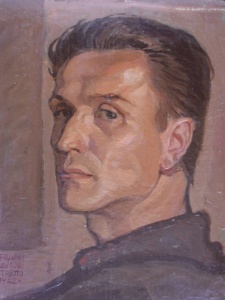
Was an extraordinary painter from Foligno, who deeply loved Bevagna as a second home. He died prematurely at 34 years old. His works consist of portraits (among the most recurrent the self-portraits and those of his mother and his beautiful wife Mimma), still lifes and landscapes. The art critic Italo Tomassoni underlines how his portraits affect “for their skill of execution, their pictorialism and their resemblance to the model”. And, “whereas in still life the painter investigates the intimate and therefore” profound “and therefore the ultimate meaning of things; in the landscape it is, as in the portrait, the immediate aspect of the scene that seduces him: the quiet silence of the hour, the reassuring volume of small squares, the sun rummaging in the recesses of the courtyards, the scenes of the village “. As for the drawings by Carlo Frappi, Anton Carlo Ponti emphasized its beauty “for the author’s intimate” vision of the world, “the truthful representation, authentic of the ideational faculty of grasping the contours, the shadows, the contrasts, the poetry of nature”. (R. Segatori in the Great Dictionary of Bevagna, 7).
Luigi Frappi
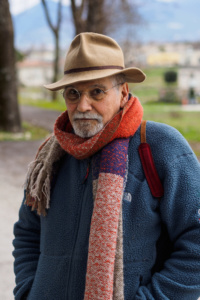
Son of Carlo, was born in Foligno on 4th August 1938. He graduated from the Bernardin Di Betto Institute of Art in Perugia and became a teacher of Pictorial Decoration and Mosaic. He soon began his artistic career, as if to continue the work interrupted by the father. After a maturation occurred in the sign of the figuration and carried out according to a convincing poetic reading of the real, even of the everyday, in the 80s it arrives, with originality of realizations, to the hypermanierism and the New Manner. The landscape outcomes to which it reaches feed ever-clear readings and interpretations; the very fact that in his landscapes you never find the presence of a human or animal figure increases the multiplicity of criticism’s suggestions. (News taken from https://digilander.libero.it/luigifrappi/Luigi_Frappi/Biografia.html).
(by Anton Carlo Ponti)


